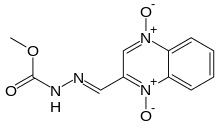Carbadox
Carbadox is a veterinary drug that combats infection in swine, particularly swine dysentery.
 | |
| Names | |
|---|---|
| IUPAC name
Methyl (2E)-2-[(1,4-dioxidoquinoxalin-2-yl) | |
| Identifiers | |
3D model (JSmol) |
|
| ChEBI | |
| ChEMBL | |
| ChemSpider | |
| ECHA InfoCard | 100.027.163 |
| EC Number |
|
PubChem CID |
|
| RTECS number |
|
| UNII | |
CompTox Dashboard (EPA) |
|
| |
| |
| Properties | |
| C11H10N4O4 | |
| Molar mass | 262.225 g·mol−1 |
| Appearance | Yellow crystals |
| Density | 1.44 g/cm3 |
| Melting point | 239.5 °C (463.1 °F; 512.6 K) |
| Insoluble | |
| Hazards | |
| GHS pictograms |   |
| GHS Signal word | Warning |
GHS hazard statements |
H228, H302 |
| P210, P240, P241, P264, P270, P280, P301+312, P330, P370+378, P501 | |
Except where otherwise noted, data are given for materials in their standard state (at 25 °C [77 °F], 100 kPa). | |
| Infobox references | |
Indications
Carbadox is indicated for control of swine dysentery (vibrionic dysentery, bloody scours, or hemorrhagic dysentery); control of bacterial swine enteritis (salmonellosis or necrotic enteritis caused by Salmonella enterica); aid in the prevention of migration and establishment of large roundworm (Ascaris suum) infections; aid in the prevention of establishment of nodular worm (Oesophagostomum) infections.[1]
Safety
In animal models, carbadox has been shown to be carcinogenic and to induce birth defects.[2] The Food and Drug Administration's Center for Veterinary Medicine has questioned the safety in light of its possible carcinogenicity.[3]
Regulation
Carbadox is approved in the United States only for use in swine and may not be used within 42 days of slaughter or used in pregnant animals.[1] In 2016, the United States Food and Drug Administration moved to ban its use in pork, citing a potential cancer risk to humans.[4] However, as of August 2018, FDA had indefinitely stayed its withdrawal of approval and carbadox remains available. [5]
In 2004, carbadox was banned by the Canadian government as a livestock feed additive and for human consumption.[6] The European Union also forbids the use of carbadox at any level.[7] Australia forbids the use of carbadox in food producing animals.[8]
References
- "21CFR 558.115". Code of Federal Regulations. FDA. 1 Apr 2014. Retrieved 23 Mar 2015.
- Yoshimura, Haruo (2002). "Teratogenic assessment of carbadox in rats". Toxicology Letters. 129 (1–2): 115–118. doi:10.1016/S0378-4274(01)00522-7.
- "Questions and Answers regarding Carbadox". Food and Drug Administration. July 31, 2019. Retrieved August 7, 2019.
- Fox, Maggie. "FDA Moves to Ban Cancer-Causing Pork Antibiotic". NBC News. Retrieved 9 Apr 2016.
- "10-K: PHIBRO ANIMAL HEALTH CORP". MarketWatch. Retrieved 3 Jul 2019.
- Maximum Residue Limits, Health Canada, 2003-05-15, retrieved 2010-07-27
- Ungemach, Fritz R. "WHO Food Additives Series: 51 CARBADOX (addendum)". WHO Food Additives Series. INCHEM. Retrieved 23 Mar 2015.
- Substances Not Permitted for use on Food-Producing Animals in Australia, Australian Pesticides and Veterinary Medicines Authority, archived from the original on 2011-02-22, retrieved 2010-08-31